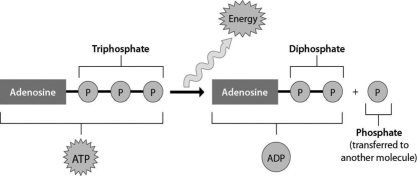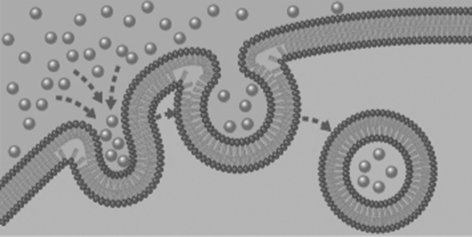A) does not use ATP as an energy source
B) moves solutes with their concentration gradient
C) can involve the transport of ions
D) is a type of facilitated diffusion
Correct Answer

verified
Correct Answer
verified
Multiple Choice
Examine the cells below. Cells with a higher concentration of ions than the surrounding medium tend to ________. 
A) stay about the same size and shape
B) expand
C) shrink
D) divide
Correct Answer

verified
Correct Answer
verified
Multiple Choice
A boulder at the top of a hill contains ________ energy.
A) potential
B) no
C) kinetic
D) conserved
Correct Answer

verified
Correct Answer
verified
Multiple Choice
Glucose molecules provide energy to power the swimming motion of sperm. In this example, the sperm are changing ________.
A) chemical energy into kinetic energy
B) chemical energy into potential energy
C) kinetic energy into potential energy
D) kinetic energy into chemical energy
Correct Answer

verified
Correct Answer
verified
Multiple Choice
How are membrane transport proteins like enzymes?
A) Both are specialized to the materials they act upon.
B) Both are made from RNA molecules.
C) Both require energy to function properly.
D) Neither can change as a result of gene mutations.
Correct Answer

verified
Correct Answer
verified
Multiple Choice
Scenario Cellular respiration converts the energy of fuel molecules to a form of energy that a cell can use to perform work. In an average day, most adult humans need to consume about 2,000 Calories to maintain their health. However, the exact amount of dietary Calories a person needs depends upon many factors, including the person's age, physical activity, size, and health. Foods that we consume vary greatly in their nutritional content and quality. A large hard-boiled egg, for example, has about 75 dietary Calories and contains about 70% of our recommended daily intake of cholesterol. -The amount of dietary Calories in one hard-boiled egg could raise the temperature of ________.
A) 75 grams of water by 1 degree Celsius
B) 750 grams of water by 1 degree Celsius
C) 1,000 grams of water by 75 degrees Celsius
D) 7,500 grams of water by 50 degrees Celsius
Correct Answer

verified
C
Correct Answer
verified
Multiple Choice
Ten kilocalories are equivalent to ________ calories.
A) 1,000
B) 10,000
C) 0) 1
D) 100
Correct Answer

verified
Correct Answer
verified
Multiple Choice
How does the figure below represent the relationship between energy and ATP? 
A) The addition of energy releases a phosphate group from ATP.
B) ATP can perform cellular work when it releases a phosphate group.
C) ATP can be converted to ADP by adding a phosphate group.
D) Energy is released from ATP during the process of cellular respiration.
Correct Answer

verified
Correct Answer
verified
Multiple Choice
Diffusion ________.
A) is the result of an energy transformation
B) requires an input of cellular energy
C) occurs when particles spread from areas where they are less concentrated to areas where they are more concentrated
D) proceeds until a dynamic equilibrium is reached
Correct Answer

verified
Correct Answer
verified
Multiple Choice
The combination of sucrose, sucrase, and water produces sucrase, glucose, and fructose. Which component of the reaction is the substrate?
A) sucrose
B) sucrase
C) glucose
D) fructose
Correct Answer

verified
Correct Answer
verified
Multiple Choice
Which statement about an enzyme is TRUE?
A) An enzyme's function depends on its three-dimensional shape.
B) An enzyme works on a broad range of substrates.
C) An enzyme is used up in chemical reactions.
D) An enzyme becomes another enzyme after a reaction.
Correct Answer

verified
Correct Answer
verified
Multiple Choice
Enzymes increase the rate of a reaction by ________.
A) increasing the temperature of the substrates
B) taking energy from reactants and transferring it to products
C) decreasing activation energy
D) binding to a substrate imposter
Correct Answer

verified
C
Correct Answer
verified
Multiple Choice
A balloon that is permeable to water but not to glucose contains a 10% glucose solution. A beaker contains a 5% glucose solution. Which statement correctly classifies the solutions?
A) The solution in the beaker is hypertonic relative to the solution in the balloon.
B) The solutions in the balloon and the beaker are isotonic to each other.
C) The solution in the balloon is hypotonic relative to the solution in the beaker.
D) The solution in the balloon is hypertonic relative to the solution in the beaker.
Correct Answer

verified
Correct Answer
verified
Multiple Choice
What cell transport is modeled by the diagram below? 
A) A liver cell uses endocytosis to take up cholesterol from the blood.
B) A tear gland cell secretes a salty solution by exocytosis.
C) A neuron uses passive transport to export dopamine.
D) An immune cell engulfs virus particles using facilitated diffusion.
Correct Answer

verified
Correct Answer
verified
Multiple Choice
Osmosis can be defined as ________.
A) the diffusion of water across a selectively permeable membrane
B) the diffusion of any small molecule across a selectively permeable membrane
C) active transport across a selectively permeable membrane
D) the diffusion of a solute across a selectively permeable membrane
Correct Answer

verified
Correct Answer
verified
Multiple Choice
In a hypotonic solution, a plant cell will ________.
A) undergo plasmolysis
B) become flaccid
C) burst
D) become turgid
Correct Answer

verified
D
Correct Answer
verified
Multiple Choice
An object at rest has no ________ energy, but it may have ________ energy resulting from its location or structure.
A) kinetic; potential
B) kinetic; heat
C) potential; kinetic
D) chemical; potential
Correct Answer

verified
Correct Answer
verified
Multiple Choice
A balloon contains a 10% glucose solution. The balloon is permeable to water but not to glucose. A beaker contains a 5% glucose solution. What will happen when the balloon is submerged in the beaker?
A) The volume of water in the beaker will decrease.
B) The volume of water in the beaker will increase.
C) The amount of glucose in the beaker will increase.
D) The amount of glucose in the beaker will decrease.
Correct Answer

verified
Correct Answer
verified
Multiple Choice
Scenario Cellular respiration converts the energy of fuel molecules to a form of energy that a cell can use to perform work. In an average day, most adult humans need to consume about 2,000 Calories to maintain their health. However, the exact amount of dietary Calories a person needs depends upon many factors, including the person's age, physical activity, size, and health. Foods that we consume vary greatly in their nutritional content and quality. A large hard-boiled egg, for example, has about 75 dietary Calories and contains about 70% of our recommended daily intake of cholesterol. -Molecules that come from the food we eat provide energy for the amazing work that goes on inside of our cells. This energy, stored inside of our food, is a form of ________.
A) potential energy called chemical energy
B) potential energy called entropy
C) kinetic energy called heat
D) electrical energy called heat
Correct Answer

verified
Correct Answer
verified
Multiple Choice
The combination of sucrose, sucrase, and water produces sucrase, glucose, and fructose. Which component of the reaction is the enzyme?
A) sucrose
B) sucrase
C) glucose
D) fructose
Correct Answer

verified
Correct Answer
verified
Showing 1 - 20 of 58
Related Exams